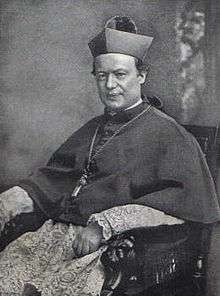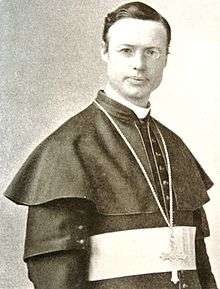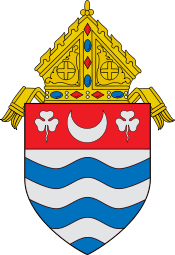Michael Corrigan
| His Excellency Michael Augustine Corrigan | |
|---|---|
| Archbishop of New York | |
 | |
| See | New York |
| Appointed | October 1, 1880 (Coadjutor) |
| Installed | October 10, 1885 |
| Term ended | May 5, 1902 |
| Predecessor | John McCloskey |
| Successor | John Murphy Farley |
| Orders | |
| Ordination | September 19, 1863 |
| Consecration |
May 4, 1873 by John McCloskey |
| Personal details | |
| Born |
August 13, 1839 Newark, New Jersey |
| Died |
May 5, 1902 (aged 62) New York, New York |
| Buried | St. Patrick's Cathedral, New York |
| Nationality | United States |
| Previous post |
|
| Motto |
DOMINUS PETRA MEA (The Lord Is My Rock) |
| Coat of arms |
 |
| Styles of Michael Augustine Corrigan | |
|---|---|
 | |
| Reference style | The Most Reverend |
| Spoken style | Your Excellency |
| Religious style | Archbishop |
Michael Augustine Corrigan (August 13, 1839 – May 5, 1902) was an American prelate of the Roman Catholic Church who served as the third archbishop of New York from 1885 to 1902.
Early life
Michael Augustine Corrigan was born August 13, 1839 in Newark, New Jersey, the fifth of nine children of Thomas and Mary English Corrigan, both of whom had emigrated from Ireland. Thomas Corrigan owned a retail grocery and liquor business in Newark, and the family's well-to-do status allowed Michael to pursue his educational interests. He attended St. Mary's College in Wilmington, Delaware, from 1853–1855, Mount Saint Mary's University in Emmitsburg, Maryland from 1855–1857, spent a year in Europe, and received his bachelor's degree from Mount Saint Mary's in 1859. He became a member of the first class at the North American College in Rome, was ordained to the priesthood in September 1863 at the Basilica of St. John Lateran, and received a doctorate of divinity in 1864.[1]
Corrigan returned to New Jersey in 1864, where he joined the faculty at Seton Hall College and the Immaculate Conception Seminary, both in South Orange, as professor of theology and history. He soon achieved a reputation within the hierarchy for sound scholarship, and he also provided pastoral care to Catholics in the Seton Hall vicinity. When Bernard J. McQuaid left Seton Hall in 1869 to assume his duties as bishop of the Diocese of Rochester, Corrigan succeeded him as college president and also became vicar general of the Diocese of Newark.[1]
Bishop of Newark

Corrigan succeeded James Roosevelt Bayley as bishop of Newark, becoming the second ordinary of the diocese. He was consecrated bishop on May 4, 1873.[1] The diocese encompassed the entire state of New Jersey during Corrigan's tenure. He administered diocesan affairs during a time of rapid population growth, Roman Catholic institutional development, immigration from Ireland and Germany, and considerable urbanization in the northern part of the state.
Archbishop of New York
Corrigan was appointed Coadjutor Archbishop to John Cardinal McCloskey of New York on October 1, 1880,[2] with the titular see of Petra, and succeeded to the archbishopric on October 10, 1885, serving as archbishop until his death.
Corrigan's career in New York proved controversial on a number of levels. He aligned himself closely with his former mentor, Bernard J. McQuaid and has been considered one of the leaders of the "conservative" movement within the American Catholic hierarchy. He proved to be a strong supporter of national parishes[2] and parochial schools, a vocal opponent of John Ireland, James Gibbons and other bishops who advocated "Americanization" within the Catholic Church. Within the American hierarchy, he was the closest supporter of the Pope Leo XIII on Testem benevolentiae nostrae. He also proved unpopular with many bishops for his involvement in backstage intrigue at the Vatican.
Within the Archdiocese of New York his most serious controversy involved his conflict with Father Edward McGlynn. During the 1886 mayoral campaign in New York City, the outspoken McGlynn supported Henry George, the candidate of the United Labor Party who proved popular with labor organizers, radicals, socialists, and Irish nationalists. Corrigan himself had been very close to Tammany Hall and ordered McGlynn to refrain from politics. McGlynn refused, continued to clash with the bishop, and ultimately was removed as pastor of St. Stephen's Church in New York. McGlynn was summoned to Rome but refused on the grounds of ill health and was excommunicated in 1887. The censure was eventually lifted in 1892. This highly public scandal took its toll on Corrigan and contributed to his poor relationships with an influential group of New York intellectual priests. His greatest accomplishment probably involved the building of a new seminary, St. Joseph's Seminary, Dunwoodie.
In 1897, Edgardo Mortara preached in St. Patrick's Cathedral New York City, but the Archbishop of New York told the Holy See that he opposed Mortara's efforts to evangelize the Jews on the grounds that such efforts might embarrass the Church in the view of the United States government. He also had invited Mother Cabrini to New York, but had to withdraw his invitation. By then Mother Cabrini and her missionaries had already embarked on their sea voyage to New York.
Corrigan slipped and fell when inspecting the excavation of the seminary in 1902. He contracted pneumonia during his convalescence and died. He was interred in the crypt under the altar of St. Patrick's Cathedral.
| Ordination history of Michael Corrigan | |
|---|---|
Priestly ordination | |
| Date of ordination | 19 September 1863 |
Episcopal consecration | |
| Principal consecrator | John McCloskey |
| Co-consecrators | William George McCloskey |
| Date of consecration | 4 May 1873 |
Bishops consecrated by Michael Corrigan as principal consecrator | |
| Winand Michael Wigger | 1881 |
| Patrick Anthony Ludden | 1887 |
| Charles Edward McDonnell | 1892 |
| Henry Gabriels | 1892 |
| Thomas Martin Aloysius Burke | 1894 |
| James Augustine McFaul | 1894 |
| John Murphy Farley | 1895 |
| James Edward Quigley | 1897 |
| John Joseph O’Connor | 1901 |
See also
References
- 1 2 3 Mooney, Joseph. "Michael Augustine Corrigan." The Catholic Encyclopedia Vol. 4. New York: Robert Appleton Company, 1908. 8 October 2015
- 1 2 Grace CVI, Madeline. "John Ireland and Michael A. Corrigan", OSV Newsweekly, August 28, 2009
Sources
- Joseph F. Mahoney and Peter J. Wosh, The Diocesan Journal of Michael Augustine Corrigan, Bishop of Newark, 1872–1880 (Newark: New Jersey Historical Society, 1987)
- Carl D. Hinrichsen, "The History of the Diocese of Newark, 1873–1901," (Ph.D. diss., Catholic University of America, 1962)
- Robert Emmet Curran, Michael Augustine Corrigan and the Shaping of Conservative Catholicism in America, 1878–1902 (NY: Arno Press, 1978)
- Thomas Shelley, The Archdiocese of New York: A Bicentennial History, 1808–2008 (France: Editions du Signe, 2007)
![]() This article incorporates text from a publication now in the public domain: Herbermann, Charles, ed. (1913). "article name needed". Catholic Encyclopedia. New York: Robert Appleton.
This article incorporates text from a publication now in the public domain: Herbermann, Charles, ed. (1913). "article name needed". Catholic Encyclopedia. New York: Robert Appleton.
| Catholic Church titles | ||
|---|---|---|
| Preceded by James Roosevelt Bayley |
Bishop of Newark 1873 - 1880 |
Succeeded by Winand Wigger |
| Preceded by – |
Coadjutor Archbishop of New York 1880 – 1885 |
Succeeded by – |
| Preceded by John McCloskey |
Archbishop of New York 1885 – 1902 |
Succeeded by John Murphy Farley |

